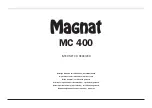
Part No. 5375-901, Rev E.1
MaxiProx
®
Installation Guide
Page 16 of 19
March 2012
© 2008 - 2012 HID Global Corporation. All rights reserved.
4.1.5
Example Output
The following is an example of an ID card with the number of “
816
” decimal, which will be output by the
MaxiProx reader, the number “
02004CA0661
” hex.
Note
: The customer code is never transmitted or displayed.
4.2
Clock-and-Data Interface
The following sections outline the MaxiProx Clock-and-Data Interface.
4.2.1
Message Format
The Clock-and-Data interface consists of three signals, Card Present, Data and Strobe/Clock. The
interface is a serial data stream, which is controlled with a clock/strobe that indicates when data is
valid. All signals are quiescent high.
Card Present
goes low when data is about to be sent and
remains low until the whole data stream is completed.
Data
is the signal that determines the “ones”
and “zeros”.
Strobe/Clock
is the signal that indicates when data is valid for each cycle.
The
Track 2
message format is a stream of binary bits that are grouped into HEX characters. The
message starts with leading zeros, followed by a start sentinel, data, end sentinel, LRC and trailing
zeros. Each HEX character has error correction in the form of a parity bit. Each character consists of
five bits. The maximum number of characters for a magnetic strip card encoded on
Track 2
are 40, this
product will output less than 40 characters. The data consists only of
BCD
digits, the remaining HEX
digits,
A
to
F
, are used for the start and end sentinel, data separators and control. Only hex
B
and
F
are
used,
A, C D
and
E
are not used. The message will consist of a minimum of 210 bits.
The bits of a character are in the order
1248P
, where parity is odd over the four bits. The LRC is the
Xoring of the message, starting with the start sentinel and ending with the end sentinel. The LRC does
not include the parity bits of the characters in the Xoring. LRC does include its own odd parity bit that
covers the four bits that are the result of the Xoring.
<leading zeros><Start Sentinel><data><data>........<data><End sentinel><LRC><trailing zero>
Customer code
0,1, 63, 72
and
73
(existing customer codes) cards will be read and output in the
Track 2
format. The data on these cards will be packed into the
Track 2
format in segments of three bits, so
the character does not exceed a
BCD
seven.
sentinel parity
parity
customer code 10 zeros
bit even facility code
card number
odd
[0 0 0 0 0 0 1] [0 0 0 0 0 0 0 0 0 0] [1] [0] [0 1 1 0 0 1 0 1] [0 0 0 0 0 0 1 1 0 0 1 1 0 0 0 0] [1]
| 0 | 2 | 0 | 0 | 4 | C | A | 0 | 6 | 6 | 1
Wiegand Output
| 0 | C | A | 0 | 6 | 6 | 1
Hex code numbers
[ 6 | 5 ][ 0 | 3 | 3 | 0 ]
Decimal conversion
[ 101
][ 0816
]




































